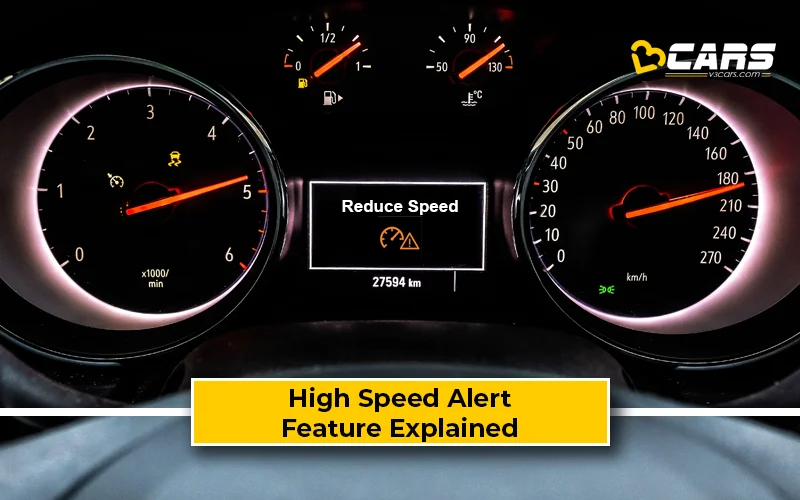What Is High-Speed Alert? Feature Explained
In this Feature Explained article, we'll delve into the crucial safety feature known as the High-Speed Alert system, a standard inclusion in all new cars sold in India since 2019. We’ll explore what it is, how it works, its vital role in enhancing road safety within the Indian context, and its different levels of alerts. Understanding this feature will highlight its importance in promoting responsible driving habits and mitigating the risks associated with speeding.

What Is High-Speed Alert?
The High-Speed Alert system is a mandatory safety feature in India designed to warn drivers when their vehicle exceeds pre-defined speed limits. This audible warning serves as a constant reminder to maintain safe speeds, contributing significantly to reducing accidents caused by over-speeding, a major concern on Indian roads.
How Does High-Speed Alert Work?
The High-Speed Alert system is integrated into the vehicle’s electronics and relies on the following:
- Speed Sensor: The vehicle’s speedometer sensor continuously monitors the current speed.
- Pre-set Speed Thresholds: The system is programmed with 2 primary speed thresholds, as mandated by Indian regulations:
- 80kmph: When the vehicle crosses this speed, the system initiates the first level of alerts.
- 120kmph: When the vehicle crosses this higher speed, a more persistent and noticeable level of alerts is activated.
- Audible Warnings: When the vehicle breaches these speed limits, the system triggers audible warnings to alert the driver. These warnings typically consist of:
- Intermittent Beeps (at 80kmph): A series of short beeps that sound periodically to remind the driver they have exceeded the first speed threshold.
- Continuous Beeps (at 120kmph): A constant and more insistent beeping sound to immediately draw the driver’s attention to the significantly higher speed.
- Visual Warnings (in some vehicles): While the primary alert is audible, some vehicles may also complement it with a visual warning on the instrument cluster, such as a flashing speed indicator or a specific warning icon.
Why Is High-Speed Alert Important In The Indian Context?
Over-speeding is a significant contributor to road accidents and fatalities in India. Factors such as varied road conditions, mixed traffic, and often undisciplined driving behavior amplify the risks associated with high speeds. The High-Speed Alert system plays a vital role in:
- Promoting Responsible Driving: The constant audible reminders encourage drivers to be more conscious of their speed and adhere to safer limits.
- Reducing Accidents: By alerting drivers to excessive speeds, the system aims to prevent accidents caused by loss of control, increased braking distances, and higher impact forces.
- Enhancing Occupant Safety: Lower speeds in the event of a collision significantly reduce the severity of injuries for the vehicle occupants.
- Contributing to Overall Road Safety: By influencing driver behavior, the High-Speed Alert system contributes to a safer environment for all road users, including pedestrians, cyclists, and other vehicles.
- Mandatory Compliance: As a mandatory safety feature, it ensures that all new vehicles actively contribute to speed awareness on Indian roads.
Levels Of High-Speed Alert
As mentioned earlier, the High-Speed Alert system in India operates on 2 primary levels:
- Level 1 (80kmph): Intermittent beeps serve as an initial warning that the vehicle has crossed the 80kmph mark. This acts as a gentle reminder to ease off the accelerator.
- Level 2 (120kmph): Continuous beeps provide a more urgent and persistent warning that the vehicle has entered a significantly higher and potentially dangerous speed zone. This level demands immediate attention from the driver to reduce speed.
Is It Possible To Disable High Speed Alert In A Car?
It is not legally possible to disable the High-Speed Alert system in cars sold in India that are mandated to have it (all new cars sold after July 1, 2019).
Here's a breakdown of why:
- Mandatory Safety Feature: The High-Speed Alert system was made a mandatory safety feature by the Indian government to curb over-speeding and reduce road accidents.
- Non-Overrideable System: Government regulations specify that this system cannot be switched off or overridden by the driver. The intention is to provide a continuous and unavoidable reminder to maintain safe speeds.
- Legal Compliance: Car manufacturers are legally required to equip their vehicles with a functioning High-Speed Alert system.
While some technical workarounds might exist through aftermarket modifications or “coding,” attempting to disable the system carries potential risks and is generally not recommended:
- Warranty Issues: Tampering with the car’s electronics can void the manufacturer’s warranty.
- Safety Compromise: Disabling a safety feature intended to prevent accidents compromises your safety and the safety of others.
- Potential Legal Implications: While a specific penalty for disabling the alert might not exist, it could be viewed negatively in case of an accident. Altering mandatory safety features goes against the spirit of the Motor Vehicles Act.
- Impact on Other Systems: Car electronics are often interconnected, and tampering with one system could affect others.
The government's intent is clear: the High-Speed Alert system's “irritating” nature, especially the continuous beeping above 120kmph, is a deliberate measure to encourage drivers to reduce speed. It is always best to adhere to traffic rules and drive at safe speeds.
Also Read: LED Headlamps – Feature Explained
Note: Check your Car EMI with our - Car Loan EMI Calculator
You can use our Fuel Cost Calculator to see how much any petrol, diesel or CNG car will cost to run based on the latest fuel price in your city.


0 Comments